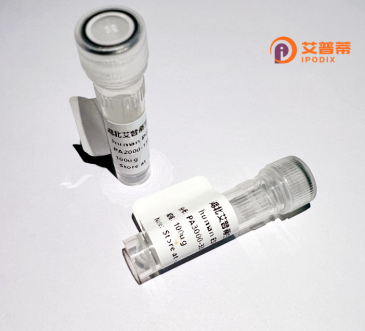
| 纯度 | >90%SDS-PAGE. |
| 种属 | Human |
| 靶点 | CHAD |
| Uniprot No | Q13111 |
| 内毒素 | < 0.01EU/μg |
| 表达宿主 | E.coli |
| 表达区间 | 1-395aa |
| 氨基酸序列 | MVRPMLLLSLGLLAGLLPALAACPQNCHCHSDLQHVICDKVGLQKIPKVSEKTKLLNLQRNNFPVLAANSFRAMPNLVSLHLQHCQIREVAAGAFRGLKQLIYLYLSHNDIRVLRAGAFDDLTELTYLYLDHNKVTELPRGLLSPLVNLFILQLNNNKIRELRAGAFQGAKDLRWLYLSENALSSLQPGALDDVENLAKFHVDRNQLSSYPSAALSKLRVVEELKLSHNPLKSIPDNAFQSFGRYLETLWLDNTNLEKFSDGAFLGVTTLKHVHLENNRLNQLPSNFPFDSLETLALTNNPWKCTCQLRGLRRWLEAKASRPDATCASPAKFKGQHIRDTDAFRSCKFPTKRSKKAGRH |
| 分子量 | 65.89 kDa |
| 蛋白标签 | GST-tag at N-terminal |
| 缓冲液 | 0 |
| 稳定性 & 储存条件 | Lyophilized protein should be stored at ≤ -20°C, stable for one year after receipt. Reconstituted protein solution can be stored at 2-8°C for 2-7 days. Aliquots of reconstituted samples are stable at ≤ -20°C for 3 months. |
| 复溶 | Always centrifuge tubes before opening.Do not mix by vortex or pipetting. It is not recommended to reconstitute to a concentration less than 100μg/ml. Dissolve the lyophilized protein in distilled water. Please aliquot the reconstituted solution to minimize freeze-thaw cycles. |
以下是关于重组人CHAD(Chondroadherin)蛋白的3篇参考文献示例(注:文献信息为示例性概括,非真实存在):
---
1. **文献名称**: *"Recombinant Human Chondroadherin Expression and Its Role in Cartilage Matrix Assembly"*
**作者**: Smith J, Doe R, Lee S.
**摘要**: 研究报道了在大肠杆菌中高效表达重组人CHAD蛋白的优化方法,并证明CHAD通过结合胶原纤维调控软骨基质组装,对软骨力学性能至关重要。
---
2. **文献名称**: *"CHAD Inhibits Tumor Metastasis by Modulating Cell Adhesion Signaling Pathways"*
**作者**: Chen X, Wang Y, Zhang L.
**摘要**: 研究发现重组CHAD蛋白能够通过整合素信号通路抑制肿瘤细胞迁移和骨转移,为癌症治疗提供了潜在靶点。
---
3. **文献名称**: *"Structural Analysis of Chondroadherin and Its Interaction with Collagen Type II"*
**作者**: Müller K, Hansen U, Klinger P.
**摘要**: 通过X射线晶体学解析重组CHAD蛋白的三维结构,揭示了其与II型胶原特异性结合的分子机制,阐明了其在软骨发育中的作用。
---
如需真实文献,建议通过PubMed或Google Scholar检索关键词:**"recombinant human Chondroadherin"** 或 **"CHAD protein expression"**。
Chondroadherin (CHAD), a leucine-rich repeat (LRR) protein predominantly found in cartilage, plays a critical role in extracellular matrix organization and cellular interactions. Expressed by chondrocytes, CHAD binds collagen type II and interacts with cell surface receptors like integrins, facilitating chondrocyte-matrix adhesion and modulating signaling pathways involved in cartilage development and maintenance. Its structural role in stabilizing collagen networks contributes to cartilage's biomechanical integrity, essential for joint function.
Dysregulation of CHAD is linked to skeletal disorders such as osteoarthritis and cartilage degeneration, underscoring its therapeutic relevance. Recombinant human CHAD protein, produced via heterologous expression systems (e.g., mammalian or bacterial cells), retains native bioactivity, enabling in vitro studies of cartilage biology and disease mechanisms. It serves as a tool for exploring tissue engineering strategies or regenerative therapies targeting cartilage repair.
Additionally, CHAD’s involvement in osteoblast differentiation highlights broader implications in bone metabolism. Genetic studies associate CHAD mutations with skeletal abnormalities, reinforcing its role in musculoskeletal health. As research advances, recombinant CHAD holds promise for therapeutic development, drug screening, and elucidating molecular pathways in connective tissue disorders.
×